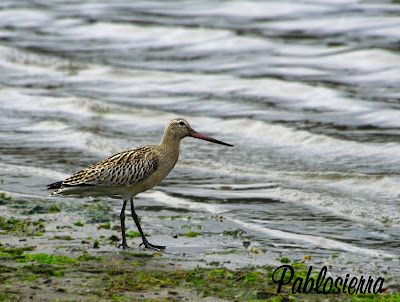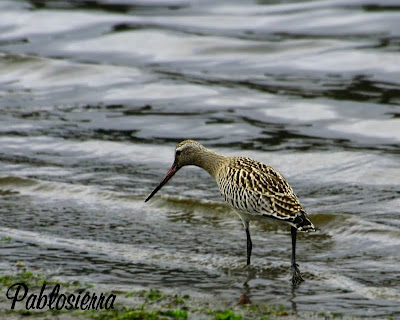
 ringed plover. (Charadrius hiaticula).
ringed plover. (Charadrius hiaticula). This specimen is a juvenile spotted on the beach in Navia, Asturias. I have to thank Eteban War, assisting with the identification, it was torn between this or a Semipalmated Chortlitejo. (Charadius semipalmeatus).
The images are not of great quality was testing with the duplicator. I've been very happy, as you can see quite clearly lost.
I leave a picture without the duplicate so you can see the magnification you get. (The distance would not be exactly the same, but did not differ too much)

Of the three species of plovers common in our country, the great, is the only one who does not play here because it is a bird's own high latitudes of the northern hemisphere, which only appears on our shores and wetlands in winter time in which you can see, both in the Mediterranean coasts and, especially, bathed in the Atlantic.
The reproductive cycle of this limicola, takes about 50 days, of which 25 correspond to the incubation of 3 to 4 eggs are the usual fantastic and the rest of the development of chickens.
The nest is usually located bare soil (raramante hidden among the vegetation) and is usually a simple depression in the sand just bounded by some plant materials.
During the breeding season, usually feed on small invertebrates, while elsewhere, including in diet polychaete worms, crustaceans and molluscs. Locate their prey by sight and after a short but fast race, with peak catches.
The reproductive cycle of this limicola, takes about 50 days, of which 25 correspond to the incubation of 3 to 4 eggs are the usual fantastic and the rest of the development of chickens.
The nest is usually located bare soil (raramante hidden among the vegetation) and is usually a simple depression in the sand just bounded by some plant materials.
During the breeding season, usually feed on small invertebrates, while elsewhere, including in diet polychaete worms, crustaceans and molluscs. Locate their prey by sight and after a short but fast race, with peak catches.





